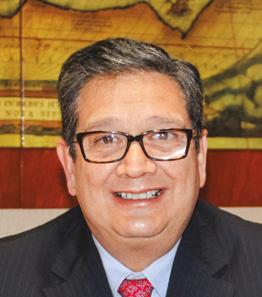
3 minute read
USMCA RATIFICATION WILL LEAD TO INVESTMENT CERTAINTY, GROWTH
ÓSCAR ALBIN
Executive President of INA
Q: How can Mexico maintain its position as the fifth-largest supplier of automotive components worldwide? A: Mexico has several characteristics that make it attractive
for the production of automotive components. One is its geographic proximity to the US and Canada. We are the only low-cost country in the North American region, so the 17 million vehicles produced in the NAFTA region have Mexican auto parts. The strength of the US market has given us the opportunity to grow in past years. We are the most important supplier of auto parts to the US and Canada. Another advantage is the renegotiation of NAFTA, now USMCA. Its successful renegotiation provided guarantees to investors and companies in Mexico to continue producing for the NAFTA market.
The automotive and auto parts industry in Mexico is very dynamic. Domestic consumption is decreasing but export activity is robust. Brazil is also helping exports grow. Since the Brazilian economy is expanding, we are exporting more to the country. Moreover, in March 2019, Mexico and Brazil launched a free trade agreement, which boosted our commercial relationship. Although demand from Brazil will not equal that in the US, it will help us boost our exports.
Q: What main threats could hamper the growth of the Mexican auto parts industry? A: A main risk is the availability of qualified labor, which includes blue-collar workers, technicians and engineers. Some parts of the country are practically saturated but other areas have no space to continue growing. Migration toward industrial areas is not ideal because it generates social problems. The ideal solution would be for the industry to move toward cities with workforce availability. This is something the government needs to promote through federal policies.
The National Auto Parts Industry (INA) is the organization
that represents auto parts companies established in Mexico. Another aspect that limits growth is job security. The new Federal Labor Law establishes significant changes in the employer-employee relationship and both sides need to learn how to best work together. This change is necessary and mandatory, not only because of USMCA but also because of Mexico’s commitment to the International
Labor Organization.
Q: Now that USMCA is almost enforced, how are INA and its members working to comply with new local content standards?
A: These new standards will benefit auto parts producers across North America. Companies that use components that are imported from outside the region will have to find a way to buy them or produce them locally. This will surely lead to investments in all three countries. It will be a gradual process and Mexico could use it to attract more FDI. Still, we need political and investment security and a robust implementation of USMCA.
Q: How is INA supporting smaller suppliers to help them comply with quality standards and speed up the process of complying with local content requirements? A: Rather than helping them to develop manufacturing and quality standards, we are helping smaller players to connect with Tier 1s through opportunity identification programs. If they do not see a business opportunity, companies will hardly invest in new machinery and quality processes. We have developed a supplier development program, with SE’s support, through which we visit around 150 suppliers, audit them and link them with potential clients.
Q: How on track is Mexico to reach fourth place among the largest automotive component manufacturers in the world?
A: We are very well on track to reach Germany’s production volume. As a consequence of the commercial war between the US and China, North America will have the opportunity to attract more Chinese investment for auto parts production and we will surely see some Chinese companies arrive to Mexico.

USMCA RATIFICATION WILL LEAD TO INVESTMENT CERTAINTY, GROWTH
ÓSCAR ALBIN
Executive President of INA










